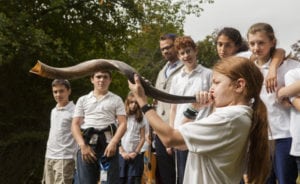Jake Hyman isn’t what you would call a novice shofar blower, but he recalls what it felt like to be one.
The 13-year-old stood before his congregation, Keneseth Israel, last year during the High Holy Days, grasping the shofar his grandfather gave him. He recalls blasting out the short and long sounds synonymous with commanding Jews to awaken from their spiritual slumber and examine their deeds.
“I was a little nervous,” recalled Jake, son of Lee Hyman and Debby Rose, “but it was fun and it made me feel proud that I could do it.”
It was also something that rabbis at most area congregations encourage.
Every year, at Louisville’s synagogues, worshippers are given the chance to come to the bima, shofar in hand, and try blowing it before their community of worshippers.
In most cases, the offer comes at the conclusion of Yom Kippur, when everyone can try their hand at belting out a good, long tekiah gedolah.
“I also put out some extra shofarot” for anyone who wants to give it a try, said KI Rabbi Michael Wolk.
Rabbi Robert Slosberg of Adath Jeshurun, said he, too, opens the Neilah (concluding) service for worshippers who want to try their hand at this special mitzvah. Rabbi Beth Jacowitz Chottiner of Temple Shalom, going into her second year at that congregation, said she would do the same.
Blowing the shofar on Rosh Hashanah is a bit more complicated. A blower must be able to produce the short and long notes that tradition proscribes – tekiah, shevarim, teruah. That takes some practice.
Some rabbis prefer that their blowers first demonstrate that they can make the notes.
“I offer a three-session class that members are invited to take,” said Rabbi Gaylia R. Rooks of The Temple, “but they must get their shofar blowing ‘certified kosher’ by me prior to the service. Since there are more than just a couple [shofar blowers], it’s OK if they’re not great. I just help them improve with whatever tips I can offer.”
One of Rooks’ pupils is Michelle Elisburg, president of the Louisville Chapter of Hadassah. She took Rooks’ course last year and blew her shofar on Rosh Hashanah. The rabbi also passed out literature addressing the whys of shofar blowing as well as the hows.
“I was a religion major in college and my graduation present from my parents was a shofar,” Elisburg said, “so I had it for a really long time, but didn’t know how to blow it properly.”
Over the years, though, when she visited her home congregation in Washington, D.C., and listened as congregants stood at all corners of the sanctuary blowing their horns, she became inspired to try it herself.
“I thought, ‘Oh I could do that, I should do that, and I would do that.”
Last year with five or six other worshippers at The Temple, she did do that. She was nervous, but she said it went well enough.
“It gives you chills,” Elisburg said of the experience.
She described hearing many shofars at once as “awe inspiring,” the mix of different size horns, each producing different sounds, being reminiscent of an orchestra.
“Everyone is doing the same note at the same time,” Elisburg said, “but they all sound different.”
The satisfaction of blowing a shofar goes beyond the sound it makes.
“I feel very connected to the tradition,” Elisburg said, “because I know it was something they did in ancient times.”
The history of the shofar is grounded in Jewish tradition. According to Exodus, the sound of the shofar emanated from Mount Sinai at the giving of the Torah. The Book of Joshua records how the people of Israel marched around the walls of Jericho blowing shofarot until the walls collapsed and the city fell.
On Rosh Hashanah, however, the shofar calls the observant to reflect on their deeds of the past year, and to change.
Observant Jews say the shofar is to be blown 100 times on the New Year through a pattern of notes: the tekiah, one long, straight blast; shevarim, three medium, wailing blasts, teruah, nine quick blasts in succession, and the tekiah gedolah – one long, sustained blast that ends both the shofar service on Rosh Hashanah as well as Yom Kippur.
Though some sources describe the shofar as one of the earliest musical instruments, Wolk stops far short of that assertion.
“I actually think it’s not,” he said. “There’s no mechanism that controls the pitch that allows you to change it. There’s a few different sounds depending on how you blow it. But it’s not a musical instrument; it’s a religious item.”
Still, music can be made with it. Examples of music being played on the shofar are easy to find on the Internet, including, appropriately enough, “Hatikvah.”
In fact, when Jake Hyman first tried to blow his shofar, he thought it might be similar to the trumpet, which he was playing at the time.
It wasn’t.
“You have to put your mouth in slightly different positions,” he said. It also has just a couple pitches. It was somewhat different.”
Now that she has done this mitzvah, Elisburg is anxious to do it again this year. She admitted, though, that her shofar skills might be a little rusty.
“I suppose I need a refresher,” she quipped.



